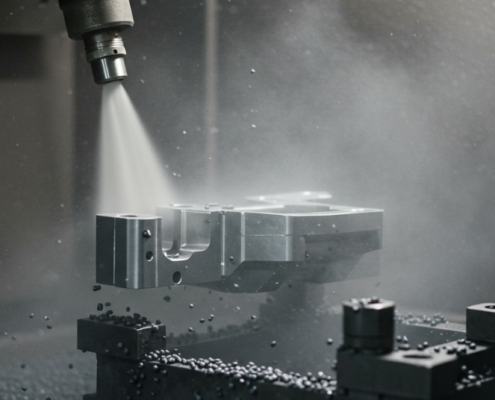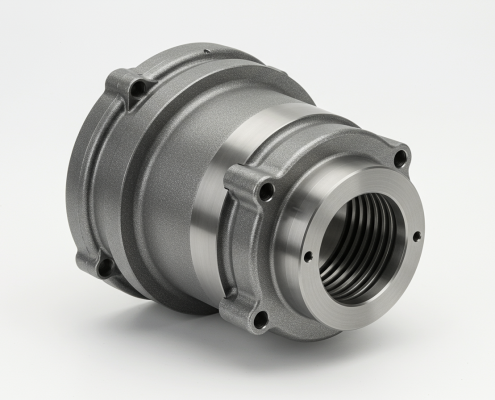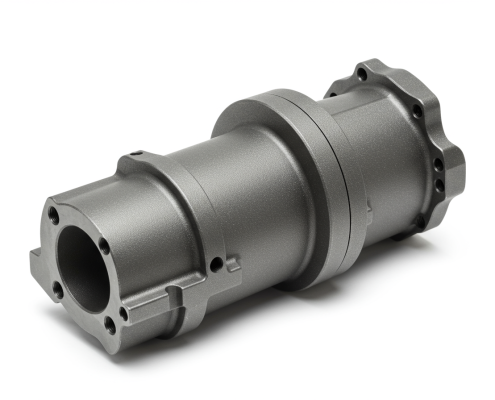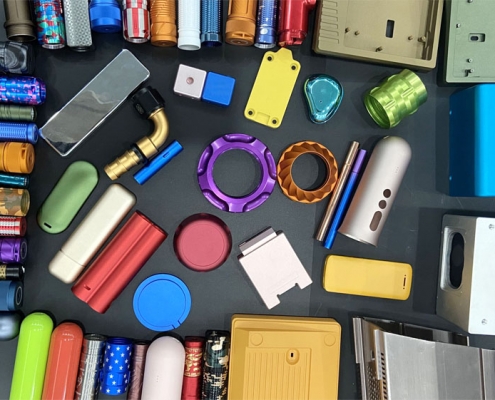Bead Blasting: The Ultimate Guide for Beginner and Expert
Bead blasting is a surface treatment process that provides a uniform texture while enhancing the performance and appearance of components. From stainless steel bead blasting to aluminum bead blasting, this technique has become an essential step in CNC machining, seamlessly blending functionality with aesthetics.
This post delves into bead blasting, exploring its working principles, benefits and drawbacks, and applications, to help you decide if it meets your project requirements.
What Is Bead Blasting?
Bead blasting is a form of abrasive blasting & coating that propels fine glass bead blasting media at high speed onto a surface using compressed air. Unlike traditional sandblast methods, bead blasting creates a uniform matte finish without removing too much base material.
It is commonly applied to bead blasted stainless surfaces, providing both aesthetic appeal and mechanical benefits such as increased friction or improved paint adhesion.When to Choose Bead Blast Finish?

How Does Bead Blasting Work?
Bead blasting starts by loading glass beads or another blasting medium into a specialized machine. Using pressurized air, the machine shoots the beads at the surface of the part, cleaning it and creating a consistent texture. The following are the steps of Bead Blasting:
- Prepare the Part: Place the part inside the bead blasting cabinet, ensuring it’s secured and ready for treatment.
- Set the Pressure: Adjust the machine’s pressure settings, typically between 40 and 80 PSI, depending on the material and desired finish.
- Blast the Surface: Use smooth, sweeping motions to spray the beads evenly across the surface for a uniform finish.
- Inspect and Clean: Once done, check the texture for consistency and wash the part to remove any residual media.
Types of Bead Blasting Media
Different bead blasting media provide various finishes, tailored to the material and purpose. The table below outlines the characteristics, common uses, and suitable applications for each type:
| Media Type | Characteristics | Common Uses | Applications |
| Glass Beads | Spherical, reusable, gentle on surfaces | Polishing aluminum, stainless steel | Achieving a satin finish, cleaning delicate parts |
| Ceramic Beads | Durable, more aggressive than glass beads | Cleaning hardened steels, tooling parts | Deburring, creating wear-resistant surfaces |
| Steel Shot | High impact, heavy-duty media | Descaling, removing heavy coatings from industrial parts | Surface hardening, rust and scale removal |
| Plastic Beads | Lightweight, used at low pressure | Sandblasting plastic and soft materials | Cleaning or removing paint without surface damage |
| Aluminum Oxide (optional) | Angular, highly abrasive | Preparing surfaces for coating or painting | Heavy-duty cleaning tasks, especially for hard metals |
Bead Blasting in CNC Machining and Manufacturing
In CNC prototyping and low-volume manufacturing, bead blasting enhances post-machined surfaces. It removes burrs, evens out tool marks, and improves adhesion for painting or anodizing.
For bead blasted aluminium, the finish improves corrosion resistance, while bead blasting titanium delivers a clean, matte aesthetic favored in aerospace.

Best Practices for Quality Bead Blast Finishes
To achieve consistent and high-quality results in bead blasting, careful attention to key factors is essential. Proper technique and maintenance ensure a uniform surface texture while avoiding defects or damage. Below are the best practices to follow for an optimal bead blast finish.
1. Maintain a Constant Nozzle Distance
Keep the nozzle at a consistent distance from the part, typically 4–8 inches, depending on the media and desired finish. Uneven distances can lead to an inconsistent texture or over-polishing in certain areas. To maintain a constant nozzle distance, use a steady sweeping motion to evenly cover the surface.
2. Ensure Media Recycling and Contamination Control
Reusing media is cost-effective, but it’s essential to filter and clean it regularly. Contaminated media can introduce scratches, cause uneven finishes, or damage delicate parts. So you can Implement a routine to replace or recycle the media to maintain surface quality.
3. Monitor Air Pressure and Humidity
Set and maintain air pressure within the optimal range, usually 40–80 PSI, to avoid over-aggressiveness or insufficient cleaning. High humidity can cause media clumping, leading to poor blasting performance. Use a moisture trap in the air supply to keep the system dry.
4. Use a Bead Blast Surface Finish Chart
Evaluate the roughness level using a bead blast surface finish chart. Typical finishes range from Ra 1.5 to Ra 3.5 µm, depending on the media and process parameters. This helps ensure the result meets the specific requirements of your project.
By adhering to these practices, you can achieve a smooth, uniform finish while preserving the integrity of the components.
What are Advantages and Disadvantages of Bead Blast Finish?
Bead blasting offers a range of benefits that make it a popular choice for surface treatment in various industries. However, it also has certain limitations that may impact its suitability for specific applications. Below are its advantages and disadvantages to help you make an informed decision.
| Aspect | Details |
| Advantages | |
| Uniform Matte Texture | Bead blasting creates a consistent, even matte finish that enhances the appearance of parts and hides minor surface imperfections. |
| Minimal Material Removal | The process only affects the surface layer, preserving part dimensions and ensuring precision, even for intricate components. |
| Non-Reactive on Metals | Bead blasting is gentle and does not chemically react with most metals, making it safe for aluminum, stainless steel, and similar materials. |
| Surface Preparation for Coating | It effectively cleans and roughens surfaces, improving adhesion for subsequent coatings, paint, or plating. |
While bead blasting has clear benefits, it’s important to consider its drawbacks to ensure it aligns with your project’s needs.
.
| Disadvantages | Details |
| Media Replacement Cost | Frequent media recycling or replacement is necessary to maintain quality, which can increase operational costs over time. |
| Surface Contamination if Not Cleaned | Residual media or dust left on the part after blasting can cause issues in subsequent processes, such as coating or assembly. |
| Not Suitable for Very Soft Materials | The process may be too aggressive for delicate or soft materials like some plastics or thin metals, leading to surface deformation. |
By considering these drawbacks alongside its benefits, you can better assess whether bead blasting aligns with your project requirements.
Bead Blasting Compared to Other Finishing Methods
Bead blasting is one of many surface preparation methods, each with its own unique advantages and application scenarios. Understanding how bead blasting compares to other technologies can help you choose the best surface preparation option for your project. Below is a detailed comparison that outlines the characteristics and common uses of bead blasting compared to other methods.
| Surface Preparation Method | Characteristics | Common Uses |
| Bead Blasting | Uses smooth, spherical media for gentle cleaning and a uniform matte finish | Surface polishing, finishing, and preparation for coatings |
| Sand Blasting | Employs sharp, angular media; highly abrasive and aggressive | Removing rust, heavy-duty cleaning of rough surfaces |
| Shot Blasting | Utilizes steel shots for high-impact cleaning and strengthening | Large-scale descaling, industrial equipment maintenance |
| Chemical Etching | Uses chemical agents to clean and prepare surfaces | Precision cleaning for delicate parts or materials sensitive to abrasion |
| Polishing | Achieves a smooth, glossy finish; lacks texturing capability | High-gloss decorative finishes and fine detailing |
Applications of Bead Blast Finish
Bead blasting is a versatile process with applications across various industries. It combines functionality with aesthetics, making it a preferred choice for precision and design-critical components.
1. Automotive Components
Bead blasting is widely used in the automotive industry for cleaning and finishing parts like rims, intake manifolds, and other visible components. It provides a uniform matte finish that enhances the aesthetics while removing minor surface defects. This process also helps prepare parts for further coatings, ensuring durability and resistance to wear.

2. Medical and Surgical Instruments
Surgical instrument housings benefit from bead blasting for its ability to create a clean, non-reflective surface. This finish improves grip and reduces glare during procedures. Additionally, the non-reactive nature of the process ensures compatibility with sensitive medical-grade metals like stainless steel and titanium.
3. Consumer Electronics
Smartphone frames and casings often undergo bead blasting to achieve a premium, matte appearance that feels smooth to the touch. This method also ensures precision in finishing, maintaining tight tolerances for these high-demand, design-oriented products.
By tailoring the bead blasting process to the specific requirements of each sector, it is possible to achieve outstanding results that enhance both the performance and appearance of components.
VMT’s High-Quality Finishing Services
We offers precise bead blast finishing for CNC machined parts, ensuring consistent quality with rigorous CPK 1.68 inspection. Our expertise in surface treatments ensures we meet the diverse needs of our clients across various industries.
We provide a variety of finishes tailored to your requirements, including bead blasting, anodizing, polishing, electroplating, powder coating, painting, PVD, laser engraving, and more. In addition to these standard options, we also offer custom surface treatments to achieve unique effects, ensuring your parts meet both functional and aesthetic expectations.

In Conclusion
Bead blasting is essential for enhancing part aesthetics and performance, especially in the CNC manufacturing industry. Whether refining a prototype or finishing a production run, understanding this process will elevate your product’s quality.
More Resources:
Aluminum Hard Anodizing: Characteristics and Applications – Resource: VMTCNC
Principles and Applications of Sandblasting – Resource: VMTCNC
What Is Polishing And Types Of The Polishing – Resource: VMTCNC
FAQ About Bead Blasting
What is the Difference Between Bead Blasting and Sand Blasting?
Bead blasting uses smooth, spherical media like glass beads to create a uniform, polished finish, making it ideal for delicate surfaces.
Sandblasting, on the other hand, uses angular media like silica sand or aluminum oxide, which are more abrasive and suitable for removing tough coatings or preparing surfaces for painting. Bead blasting is gentler, preserving fine details, while sandblasting can be more aggressive and may leave a rougher texture.
Is Bead Blasting Safe?
Bead blasting is generally safe when proper safety precautions are followed. Operators should wear protective gear, including gloves, goggles, and a respirator, to avoid exposure to dust or media particles.
The process is non-toxic and does not produce hazardous waste, making it a safer option compared to some chemical treatments. Proper ventilation is essential to ensure a safe working environment.
How Long Does Bead Blasting Take?
The duration of bead blasting depends on the size, complexity, and condition of the part. For small, straightforward components, the process can take just a few minutes.
Larger or heavily corroded parts may require more time, typically ranging from 15 to 30 minutes. The efficiency of the blasting machine and operator skill also play a role in determining the overall time.
Can You Bead Blast Aluminum?
Yes, bead blasting is an excellent choice for aluminum. It effectively cleans and polishes the surface without causing damage or warping, as the process is gentle and non-abrasive. Bead blasting aluminum can achieve a smooth, satin-like finish, making it popular in applications requiring a refined appearance, such as automotive or aerospace parts.
Can Bead Blasting Remove Rust?
Bead blasting can remove light rust and surface oxidation effectively. However, it may not be the best option for deeply pitted or heavy rust.
For severe rust, a more abrasive method, such as sandblasting or chemical rust removal, may be required before finishing with bead blasting to restore a smooth surface.
Will Bead Blasting Change Part Dimensions?
No, bead blasting does not significantly alter part dimensions. The process is designed to clean and texture the surface without removing substantial material.
Unlike grinding or machining, bead blasting only affects the outermost layer, making it ideal for precision components where maintaining accurate dimensions is critical.



